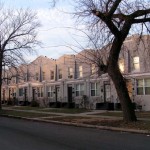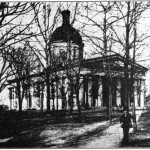In 1908, the Indianapolis Parks Department hired the world-famous planner George Kessler to serve as its landscape architect, a position he would hold for several years. During his tenure, Kessler helped transform the city’s look and feel—but first, he had to convince people that a system of parks and boulevards was a good idea.
Prior to 1870, the city had no parks to speak of—instead, open greenspaces at what are now Military Park and the State House, Court House, and University squares functioned as parks. In 1874, the city acquired Garfield Park, which sat underused and underdeveloped until Kessler’s time.
Although other design firms had suggested developing a system of parks and boulevards along the great waterways of Indianapolis, especially Fall Creek and White River, those plans received a cold reception. In the 1890s, two new ventures, Riverside and Brookside Parks, became campaign fodder for the 1899 mayoral race because people suspected that real estate speculators were responsible for their site selection.
It may be that only a person of George Kessler’s stature could have succeeded in turning around this attitude. By the time he came to Indianapolis, Kessler was famous for designing the grounds for the 1904 World’s Fair in St. Louis. He also designed park systems for Kansas City, Memphis, Cincinnati, Dallas, Houston, Salt Lake City, Denver, and Mexico City in Mexico. He would go on to work in such cities as Terre Haute.
In his first report to the city, Kessler raved about the Mile Square, with its “wide streets and ample proportions . . . splendid diagonal thoroughfares reaching out in the different directions from the business center.” But after that, Kessler found nothing to praise—he was critical of the city’s hands-off attitude toward growth.
Kessler highlighted the importance of the city’s waterways, writing that the “salient and most important portion of . . . the re-creation of a beautiful Indianapolis is based upon the existence of the streams flowing through the city.” He believed that all of the waterways—White River, Fall Creek, Pleasant Run, and Pogue’s Run—should be connected with each other by a series of wide, scenic boulevards, and that such an arrangement would tie the city together visually.
He envisioned residents driving along developed and beautified stream banks, enjoying scenic parkways, and the entire system culminating in a park stretching from the Capitol building westward to White River. While the city did not adopt all of his plans, today’s White River State Park (home of the Eiteljorg Museum of American Indians and Western Art, as well as the Indiana State Museum) may owe its existence to Kessler’s vision.
Kessler also re-designed the languishing Garfield Park, installing its famous “sunken gardens and new bridges, and designed scenic bridges at Brookside Park. In 1917 he planned the suburban enclave of Brendonwood, with its curvilinear streets, homes sited on wooded hills, and golf links.”
He also revived Riverside Park and University Park, and was working on the construction a boulevard connecting Fort Benjamin Harrison to the northwest side of town when he died unexpectedly following surgery in 1923. As a tribute, the parkway—which was completed in 1929—was named Kessler Boulevard.
A Moment of Indiana History is a production of WFIU Public Radio in partnership with the Indiana Public Broadcasting Stations. Research support comes from Indiana Magazine of History published by the Indiana University Department of History.
Sources:
1. Jacob Piatt Dunn, Greater Indianapolis: The History, the Industries, the Institutions, and the People of a City of Homes. Chicago: Lewis Publishing Company, 1910: 423, 425. (available free on Google Books)
2. George E. Kessler, “Report of Landscape Architect,” Fifteenth Annual Report of the Board of Park Commissioners For Year 1909 (Indianapolis: n.p., 1909), 16-19.
3. Connie J. Ziegler, “Kessler, George Edward,” entry in The Encyclopedia of Indianapolis, David J. Bodenhamer and Robert G. Barrows, eds. (Bloomington: Indiana University Press, 1994), 867-868.
4. Paul C. Diebold, “Kessler’s Boulevard and Park System,” entry in The Encyclopedia of Indianapolis, David J. Bodenhamer and Robert G. Barrows, eds. (Bloomington: Indiana University Press, 1994), 868-869.






















